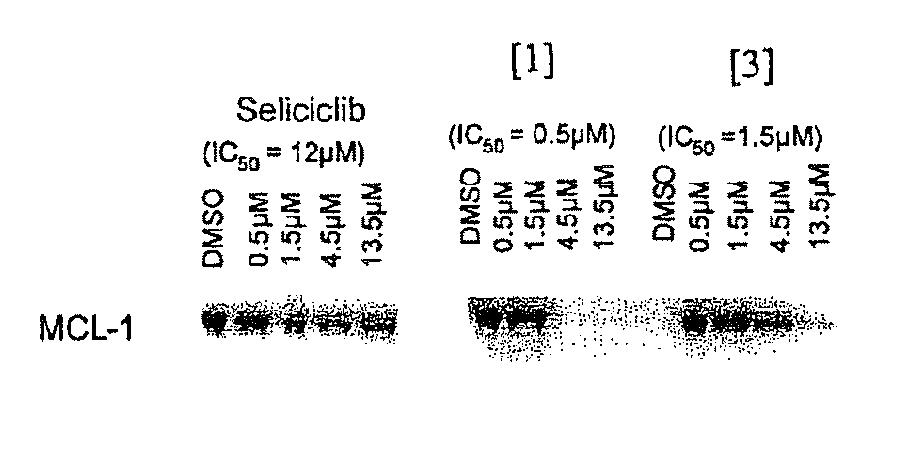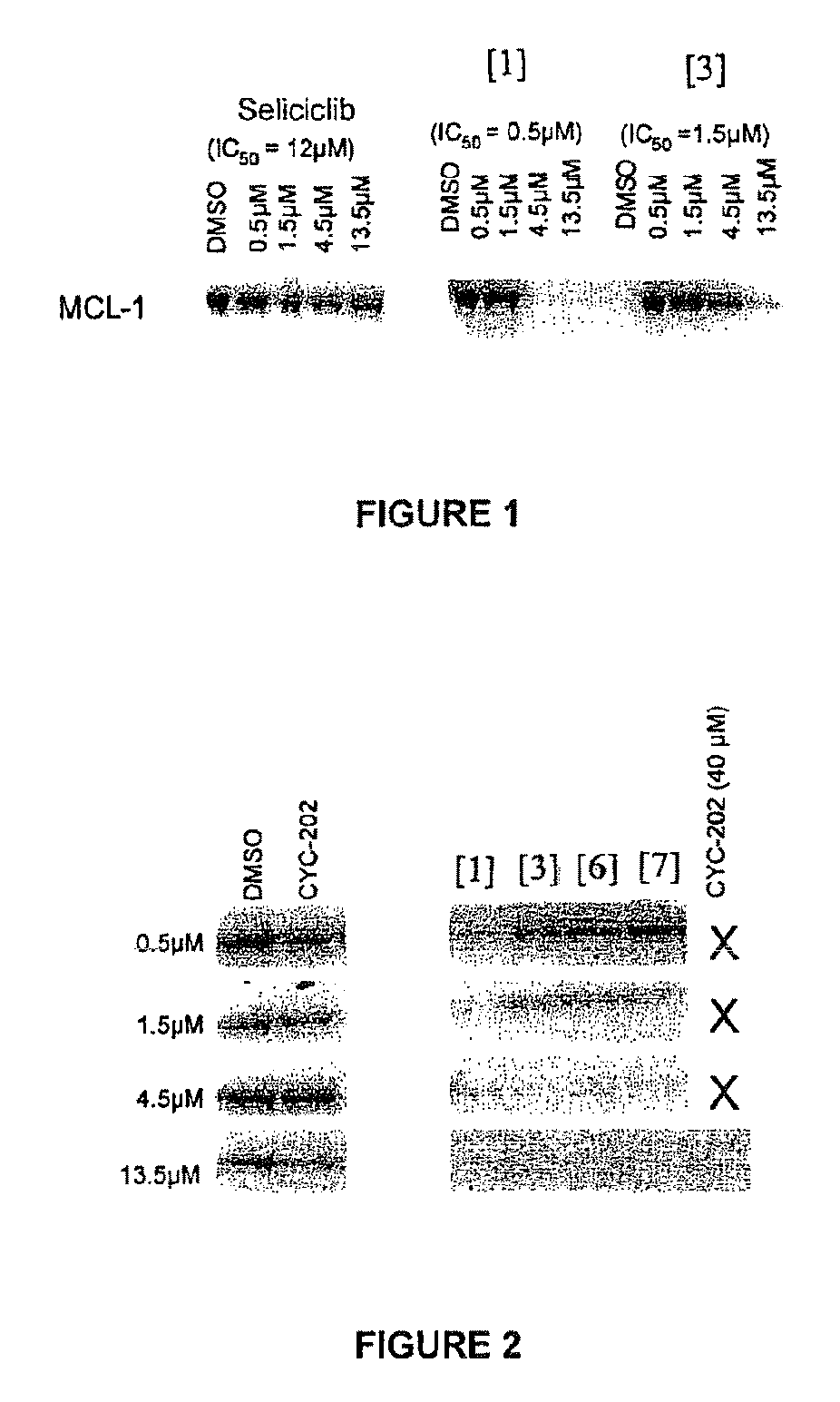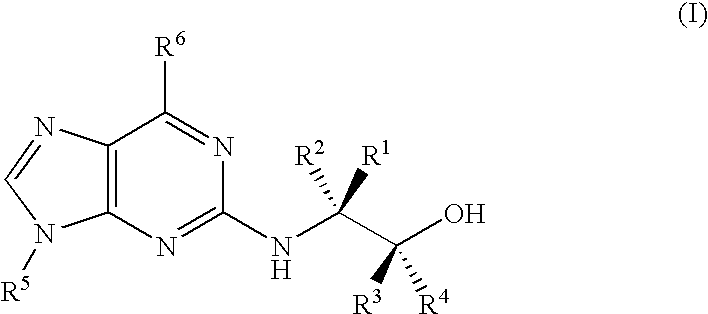Trisubstituted purine derivatives
a technology of purine derivatives and substitutions, applied in the field of new 2, 6, 9substituted purine derivatives, can solve the problem that the inhibition of rna polymerase-regulating cdks cannot be the cas
- Summary
- Abstract
- Description
- Claims
- Application Information
AI Technical Summary
Benefits of technology
Problems solved by technology
Method used
Image
Examples
example 1
2-Chloro-4,6-dimethylnicotinonitrile
[0220]
[0221]4,6-Dimethyl-2-oxo-1,2-dihydropyridine-3-carbonitrile (5 g, 34 mmol) was added to phosphorus oxychloride (20 ml). The reaction was stirred at reflux for 2 h, after which it was seen complete. Volatiles were removed and the residue triturated with petrol. The resultant solid was filtered off and washed with hexane, and dried to give a pure white solid (5.1 g, 90%). δH (250 MHz, CDCl3) 2.55 (3 H, s, CH3), 2.57 (3 H, s, CH3), 7.09 (1 H, s, ArH); δC (250 MHz, CDCl3) 162.64 (C), 154.39 (C), 152.26 (C), 123.22 (CH), 114.28 (C), 108.31 (C), 24.5 (CH3), 20.54 (CH3); m / z 189 (M+Na)
4,6-Dimethylpyridin-3-ylmethyl carbamic acid t-butyl ester
[0222]
[0223]2-Chloro-4,6-dimethyl-nicotinonitrile (5 g, 30.1 mmol) was dissolved in 10% acetic acid / ethanol (30 ml). 10% palladium over charcoal catalyst (0.5 g) was added and the reaction stirred under an atmosphere of hydrogen for 24 h. at 60° C. The mixture was filtered through a pad of celite. Volatiles wer...
example 2
2-Fluoro-N-((6-methylpyridin-3-yl)methyl)-9H-purin-6-amine
[0230]
[0231]To a stirred solution of 6-chloro-2-fluoropurine (0.4 g, 2.3 mmol) in n-BuOH (50 ml) under an argon atmosphere at 0° C., was added DIEA (2.5 ml, 14.7 mmol) followed by (6-methylpyridin-3-yl)methanamine (0.36 g, 2.95 mmol). The reaction mixture was stirred at this temperature for 1 h and then allowed to return to room temperature and stirred for 4 h, it was still seen incomplete, hence heated the reaction to 100° C. and left at that temperature for 8 h. The solvent was evaporated in vacuo and the residue was purified by gradient column chromatography on silica gel, eluted with CHCl3:MeOH (100:0→90:10), to afford the product as a white solid; Yield: 0.38 g (65%) δH CDCl3, 250 MHz) 2.44 (3 H, s, CH3), 3.66-3.57 (2 H, m, NHCH2), 4.63 (1H, s, br, NH), 7.25 (1 H, d, J 7.5, ArH), 7.71 (1 H, dd, J 2.5, 7.5, ArH), 8.14 (1 H, s, ArH), 8.49 (1 H, s, ArH), 9.07 (1 H, s, br, NH); δC (CDCl3, 250 MHz) 159.12 (C), 158.62 (C), 157...
example 3
(3-Chlorobenzyl)-(2-fluoro-9H-purin-6-yl)amine
[0236]
[0237]To a stirred solution of 6-chloro-2-fluoropurine (1 g, 1 eq, 5.9 mmol) in n-BuOH (50 ml) under an argon atmosphere, was added DIEA (2.6 ml, 2.5 eq, 14.75 mmol) followed by 3-chloro-benzylamine (1.25 g 1.5 eq, 8.85 mmol). The reaction mixture was heated at 100° C. for 3 hours after which the reaction was complete. The solvent was evaporated in vacuo and the residue purified by gradient column chromatography on silica gel, eluted with DCM:ether:MeOH (55:45:0→55:43:2), to afford the title compound as a white solid; Yield: 1.15 g (70%). δH (250 MHz, d6-DMSO) 4.78-4.6 (2 H, m, NHCH2Ar), 7.41-7.28 (4 H, m, ArH), 7.57 (1 H, s, br, ArH), 8.15 (1 H, s, br, NH), 8.88 (1 H, s, br, NH); δC (250 MHz, d6-DMSO) 142.3 (C), 133.02 (C), 132.92 (C), 130.25 (CH), 130.17 (C), 127.82 (CH), 127.27 (CH), 127.03 (CH), 126.76 (C), 125.92 (CH), 116.4 (C), 115 (C), 42.67 (CH2); m / z 278 (M+H)
(3-Chlorobenzyl)-(2-fluoro-9-isopropyl-9H-purin-6-yl)amine
[0238...
PUM
| Property | Measurement | Unit |
|---|---|---|
| temperature | aaaaa | aaaaa |
| flow rates | aaaaa | aaaaa |
| temperature | aaaaa | aaaaa |
Abstract
Description
Claims
Application Information
 Login to View More
Login to View More - R&D
- Intellectual Property
- Life Sciences
- Materials
- Tech Scout
- Unparalleled Data Quality
- Higher Quality Content
- 60% Fewer Hallucinations
Browse by: Latest US Patents, China's latest patents, Technical Efficacy Thesaurus, Application Domain, Technology Topic, Popular Technical Reports.
© 2025 PatSnap. All rights reserved.Legal|Privacy policy|Modern Slavery Act Transparency Statement|Sitemap|About US| Contact US: help@patsnap.com



